Why this resume works
- Quantifies accomplishments: By pulling actual measurable achievements like a 20% improvement in patient care efficiency, the applicant shows their impact and value.
- Highlights industry-specific skills: Healthcare skills such as therapeutic exercising and equipment maintenance highlight their suitability for healthcare roles.
- Showcases career progression: The journey from therapy assistant to physical therapy aide reflects an upward career trajectory marked by increasing responsibility in patient care and rehabilitation support.
More Physical Therapy Resume Examples
These physical therapy resume samples will guide you in creating a compelling resume for various healthcare settings.
Physical Therapy Assistant
Why this resume works
- Effective use of keywords: By weaving role-specific terms like “patient care” and “therapeutic exercise,” the applicant ensures their resume passes applicant tracking systems (ATS) with relevant keywords.
- Centers on academic background: Listing an Associate in Applied Science in the education section program shows the applicant’s strong academic foundation early in their career.
- Shows digital literacy: The resume hints at digital readiness by highlighting clinical documentation skills, a key aspect of computer skills needed today.
Occupational Therapy Aide
Why this resume works
- Includes a mix of soft and hard skills: By mixing technical skills with interpersonal skills, the applicant showcases a robust ability to improve patient care and therapy efficiency.
- Displays technical expertise: The applicant’s certifications in occupational therapy and CPR reveal a strong foundation of technical expertise important for effective patient care and safety compliance.
- Demonstrates language abilities: Possessing language skills in Spanish, French, and German improves cross-cultural communication, supporting diverse patient interactions and international collaboration.
Medical Assistant
Why this resume works
- Focuses on work history: The applicant’s use of a chronological format effectively showcases their extensive career experience and progression in healthcare roles.
- Uses action-oriented language: Action verbs like “streamlined,” “facilitated,” and “managed” convey effectiveness and initiative.
- Lists relevant certifications: Certifications such as Certified Medical Assistant illustrate the applicant’s dedication to maintaining expertise in healthcare.
Physical Therapy Aide Resume Template (Text Version)
Sophia Garcia
Detroit, MI 48207
(555)555-5555
Sophia.Garcia@example.com
Professional Summary
Dedicated Physical Therapy Aide with 6+ years in patient care and rehabilitation. Expert in enhancing recovery efficiency and maintaining therapy equipment. Proven track record in improving patient outcomes through strategic support.
Work History
Physical Therapy Aide
WellCare Rehabilitation Center – Detroit, MI
January 2023 – August 2025
- Assisted 30+ patients weekly with therapy exercises
- Maintained equipment, ensuring 100% functionality
- Improved patient care efficiency by 20%
Rehabilitation Aide
Healing Path Wellness Clinic – Southgate, MI
January 2021 – December 2022
- Supported 50+ rehab sessions monthly
- Optimized inventory, reducing costs by 15%
- Enhanced patient recovery rates by 10%
Therapy Assistant
EverGreen Health Services – Detroit, MI
January 2019 – December 2020
- Facilitated exercise routines for 25 patients/day
- Managed client scheduling, boosting visit rates by 30%
- Assisted in developing patient progress reports
Skills
- Patient Care
- Therapeutic Exercising
- Equipment Maintenance
- Inventory Management
- Scheduling
- Report Development
- Recovery Optimization
- Rehabilitation Support
Education
Master’s Kinesiology
University of Illinois Urbana-Champaign, Illinois
May 2018
Bachelor’s Exercise Science
Illinois State University Normal, Illinois
May 2016
Certifications
- Physical Therapy Aide Certification – National Healthcare Association
- CPR and First Aid – American Red Cross
Languages
- Spanish – Beginner (A1)
- French – Intermediate (B1)
- German – Beginner (A1)
Related Resume Guides
Advice for Writing Your Physical Therapy Aide Resume
Dive into our advice on how to write a resume for a physical therapy aide position and discover how to highlight your hands-on skills and passion for patient care.
Write a strong professional summary
A professional summary is a brief introduction at the top of your resume, designed to grab the attention of hiring managers.
This summary showcases your experience, skills, and achievements in three to four sentences. It’s best suited for those with some experience in the field. The purpose of this section is to highlight your professional identity and value.
On the other hand, resume objectives focus on career goals and are ideal for entry-level applicants, career changers, or those with employment gaps. Unlike summaries that emphasize accomplishments, objectives express what you aim to contribute in roles like physical therapy aide.
Next, let’s explore some examples of both summaries and objectives tailored for different industries and levels of experience.
Physical therapy aide resume summary examples
Entry-level
Recent physical therapy aide graduate with foundational knowledge in therapeutic techniques and patient care gained through clinical training. Certified in CPR and First Aid, skilled in assisting therapists with exercises and maintaining clean treatment areas. Eager to support physical therapists and contribute to improving patient mobility and comfort.
Mid-career
Experienced physical therapy aide with over three years of experience in diverse rehabilitation settings, including outpatient clinics and hospital environments. Proficient in supporting therapy sessions, handling administrative tasks, and ensuring smooth patient flow. Recognized for strong interpersonal skills, attention to detail, and the ability to motivate patients through recovery processes.
Experienced
Highly skilled physical therapy aide specializing in geriatric care with a track record of improving patient outcomes through effective team collaboration. Expert in adaptive equipment management and advanced exercise implementation for complex cases. Known for leadership in training new aides and developing streamlined patient care protocols that improve efficiency across departments.
Physical therapy aide resume objective examples
Entry-level
Enthusiastic individual with a keen interest in physical therapy seeking an entry-level position as a physical therapy aide. Aiming to leverage strong interpersonal skills and passion for patient care to assist therapists in delivering effective treatment plans and improving patient recovery experiences.
Career changer
Dedicated professional transitioning into the field of physical therapy with experience in customer service and healthcare support roles. Eager to apply transferable skills such as communication and organization to contribute positively to a physical therapy team, supporting therapists in optimizing patient rehabilitation outcomes.
Recent graduate
Recent graduate with coursework focused on anatomy and physiology, seeking a role as a physical therapy aide. Excited to bring academic knowledge and hands-on training from volunteer experiences at local clinics to provide compassionate support and assistance in patient mobility improvement efforts.
Create a standout resume quickly! The Resume Builder helps you highlight your physical therapy skills and experience, making your application shine.
Include relevant certifications and training
For a physical therapy aide, having certifications shows you’re ready for the job. They help you stand out and show you’ve learned special skills needed to support patients and therapists. Certifications prove that you’ve taken time to learn about safety and care, which is important in healthcare settings. Listing your certificates in a special section makes sure employers notice them right away.
- Certified Physical Therapy Aide (CPTA)
- Basic Life Support (BLS) Certification
- CPR/AED Certification
- First Aid Certification
- HIPAA Training
Having these certifications helps you do well as a physical therapy aide because they show you’re prepared and knowledgeable. It gives confidence to employers that you can handle the responsibilities of the job safely and effectively. Highlighting your certifications can make your resume more attractive to hiring managers.
Example of a certifications section
Certified Physical Therapy Aide
Issued by: American Medical Certification Association (AMCA)
Issued 2021
CPR and AED Certification
Issued by: American Heart Association
Expires 2025
First Aid Certification
Issued by: American Red Cross
Expires 2026
Basic Life Support (BLS) Certification
Issued by: American Heart Association
Issued 2023
Choose a polished resume template that follows a standard content hierarchy with professional fonts and straightforward resume sections.
Showcase your work experience
Your work experience on a resume is key to helping employers see why you’re a good fit for the physical therapy aide role. Highlighting relevant past jobs lets you demonstrate your skills and show how you’ve applied them in real-world settings.
When listing your experience, start with your most recent job and work backward. Each entry should include the job title, employer name, location, and employment dates. This format helps hiring managers quickly understand where you’ve worked and what you’ve done.
Use action words to describe your responsibilities in each position. Words like “assisted,” “organized,” or “prepared” make your resume more dynamic and engaging. Whenever possible, include measurable results that showcase what you achieved.
For instance, if you helped increase patient satisfaction or improved efficiency in scheduling appointments, mention those accomplishments clearly with numbers or percentages if applicable.
Include core responsibilities important for a physical therapy aide, such as maintaining equipment cleanliness, preparing treatment areas, assisting therapists with exercises, and handling administrative tasks like scheduling appointments or managing patient records.
These details provide potential employers insight into how well you’ll perform in their setting by showing the skills you’ve already developed through previous experiences.
5 physical therapy aide work history bullet points
- Assisted physical therapists in implementing treatment plans for over 25 patients weekly, ensuring efficient session flow and patient engagement.
- Maintained a clean and organized therapy area, adhering to safety protocols and reducing equipment-related incidents by 15%.
- Demonstrated proper use of therapy equipment to patients, improving their confidence and adherence to prescribed exercises.
- Monitored patient progress during therapy sessions, providing detailed feedback to therapists that improved individualized care plans.
- Scheduled appointments and managed a daily average of 30 patient records, streamlining administrative processes by 20%.
For physical therapy aides, choose a resume format that highlights your patient care experience, teamwork abilities, and relevant certifications.
Match your resume with the job description
Tailoring resumes to job descriptions is essential because it helps job seekers stand out to employers and pass through ATS. These systems scan resumes for specific keywords and phrases from job postings, ensuring only the most relevant applications reach hiring managers.
An ATS-friendly resume includes keywords and phrases directly related to the job description. By aligning your skills and experiences with these terms, you increase the chance of your resume being noticed by hiring managers and advancing in the hiring process.
To identify keywords from a physical therapy aide job posting, focus on repeated skills, qualifications, or duties like “patient care,” “clinical assessments,” or “healthcare team collaboration.” Use exact phrases from the posting wherever possible to ensure your resume matches what ATS software is scanning for.
Incorporate these terms naturally by weaving them into your work experience or skills section. For example, instead of writing “helped patients recover,” you could say “assisted patients with recovery through personalized patient care plans.” This approach demonstrates your qualifications while matching ATS criteria.
When you customize your resume, targeted content improves your chances of passing through ATS scans and catching the attention of hiring managers. Tailoring for each application ensures you’re presenting yourself as an ideal fit for the role.
Make sure your resume passes through applicant tracking systems! Our ATS Resume Checker spots common problems and gives advice to make your resume better.
FAQ
Do I need to include a cover letter with my physical therapy aide resume?
Including a cover letter with your physical therapy aide resume can really set you apart and showcase your enthusiasm for the role.
A cover letter lets you highlight your passion for patient care, explain how your skills align with the clinic’s needs, and share relevant experiences that may not fit on your resume.
For instance, if the facility specializes in sports rehabilitation or geriatric care, it’s an opportunity to emphasize any related experience or training you have.
To streamline the process, consider using a Cover Letter Generator to craft a professional and personalized letter that complements your resume effectively.
You can also explore cover letter examples specific to healthcare roles to gain inspiration and ensure your application makes a strong impression.
How long should a physical therapy aide’s resume be?
For a physical therapy aide, a one-page resume is typically sufficient to highlight your relevant skills and experience. This format allows you to showcase key abilities like patient care, familiarity with therapeutic exercises, and any certifications or training that improve your role.
If you’ve accumulated extensive experience or additional qualifications, consider a two-page resume. This option provides space to elaborate on specialized skills or detailed responsibilities in prior roles without overwhelming the reader.
To better understand how long a resume should be for different career stages, explore resources offering examples and tailored advice.
How do you write a physical therapy aide resume with no experience?
To create a compelling resume with no experience for a physical therapy aide role, focus on emphasizing your relevant skills and education that highlight you as a strong job seeker. Follow these tips:
- Highlight education and certifications: Start by listing any related coursework or degrees in fields like biology, anatomy, or kinesiology. If you’ve completed CPR certification or other relevant training, include these as well.
- Emphasize transferable skills: Showcase skills such as communication, teamwork, and organization that are essential in a healthcare setting. Mention any volunteer work or extracurricular activities that demonstrate these abilities.
- Leverage volunteer or shadowing experiences: If you’ve volunteered at a hospital or shadowed a physical therapist, detail these experiences to show your familiarity with the environment and tasks involved.
Rate this article
Physical Therapy Aide
Additional Resources
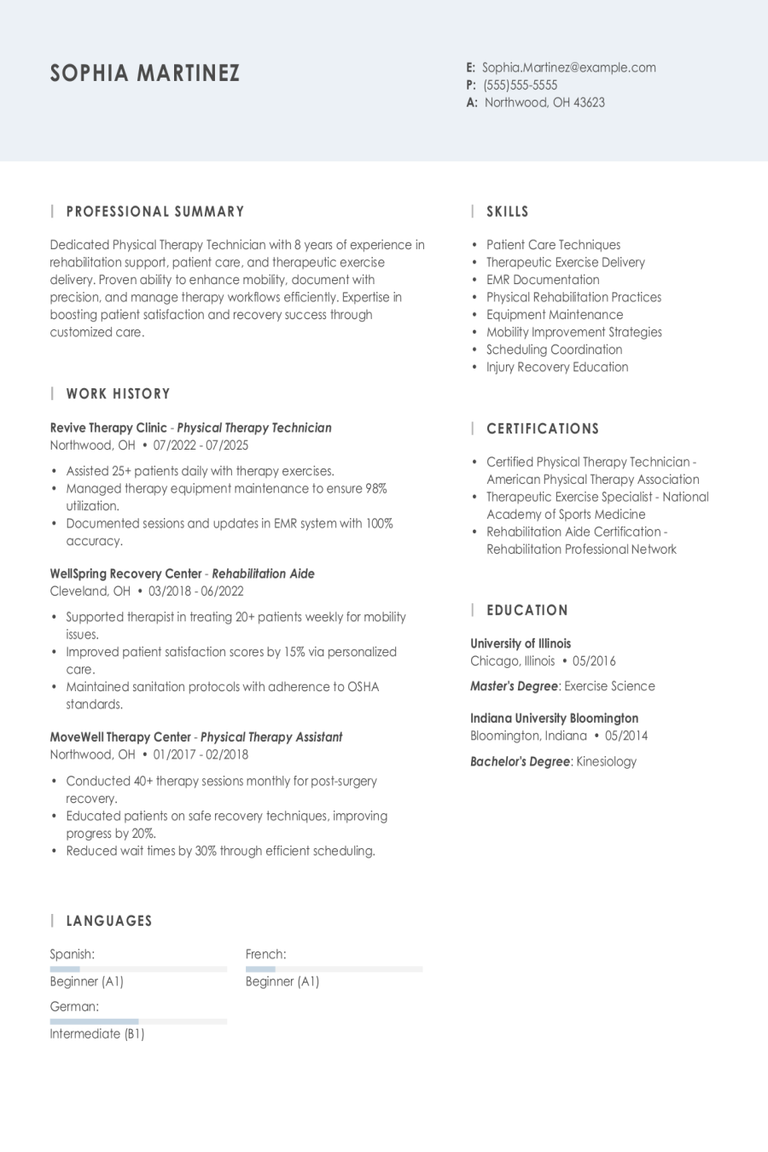
Physical Therapy Technician Resume Examples & Templates for 2025
Discover physical therapy technician resume examples and tips to help you spotlight your teamwork skills and relevant experience easily.Build my resumeImport existing resumeCustomize this templateWhy this resume worksQuantifies accomplishments: By documenting
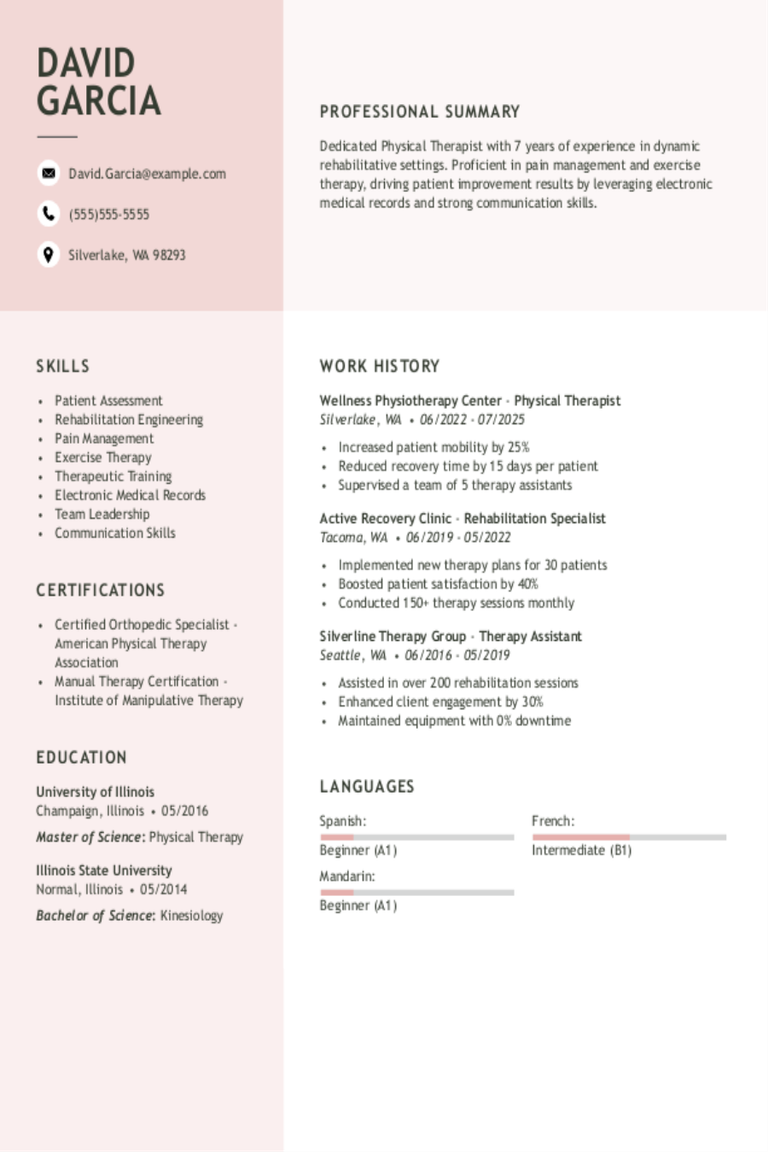
Physical Therapy Resume Examples & Templates for 2025
Explore physical therapy resume examples to see how to highlight hands-on care, patient progress, and teamwork with other health professionals. Browse tips to showcase your skills in helping people recover
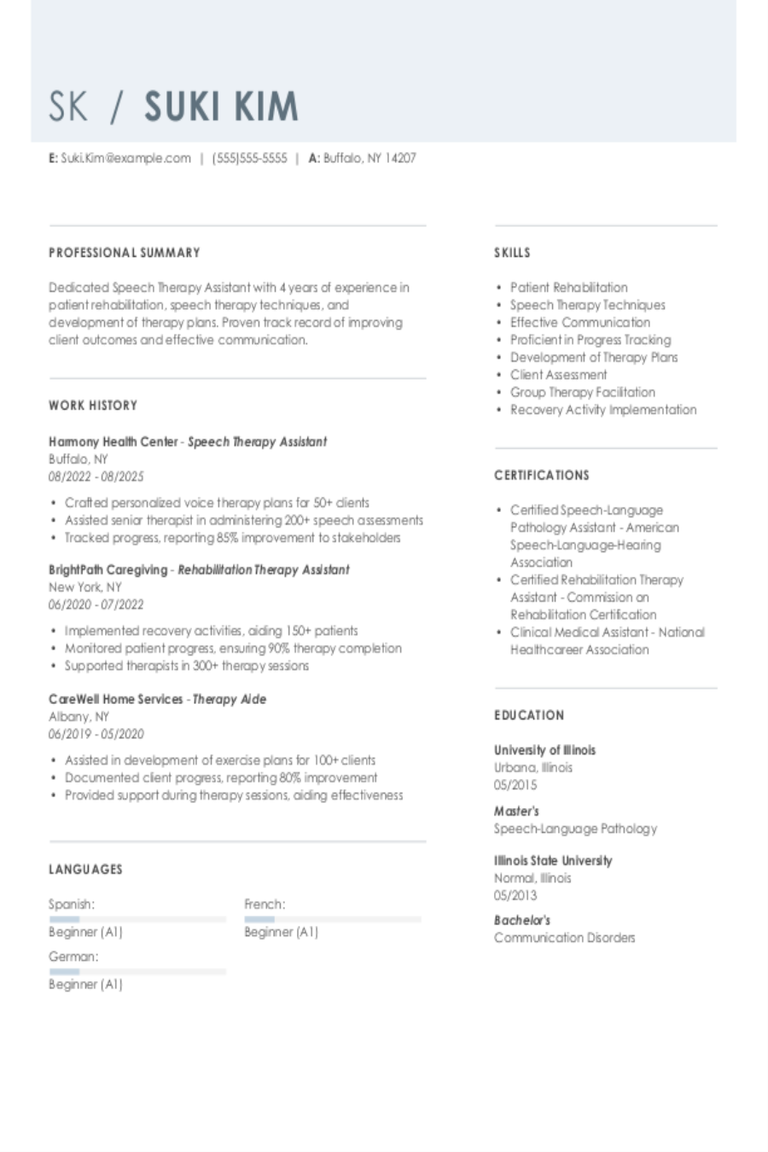
Speech Therapy Assistant Resume Examples & Templates for 2025
Explore speech therapy assistant resume examples and tips that will guide you in highlighting your skills and experiences clearly and effectively.Build my resumeImport existing resumeCustomize this templateWhy this resume worksHighlights
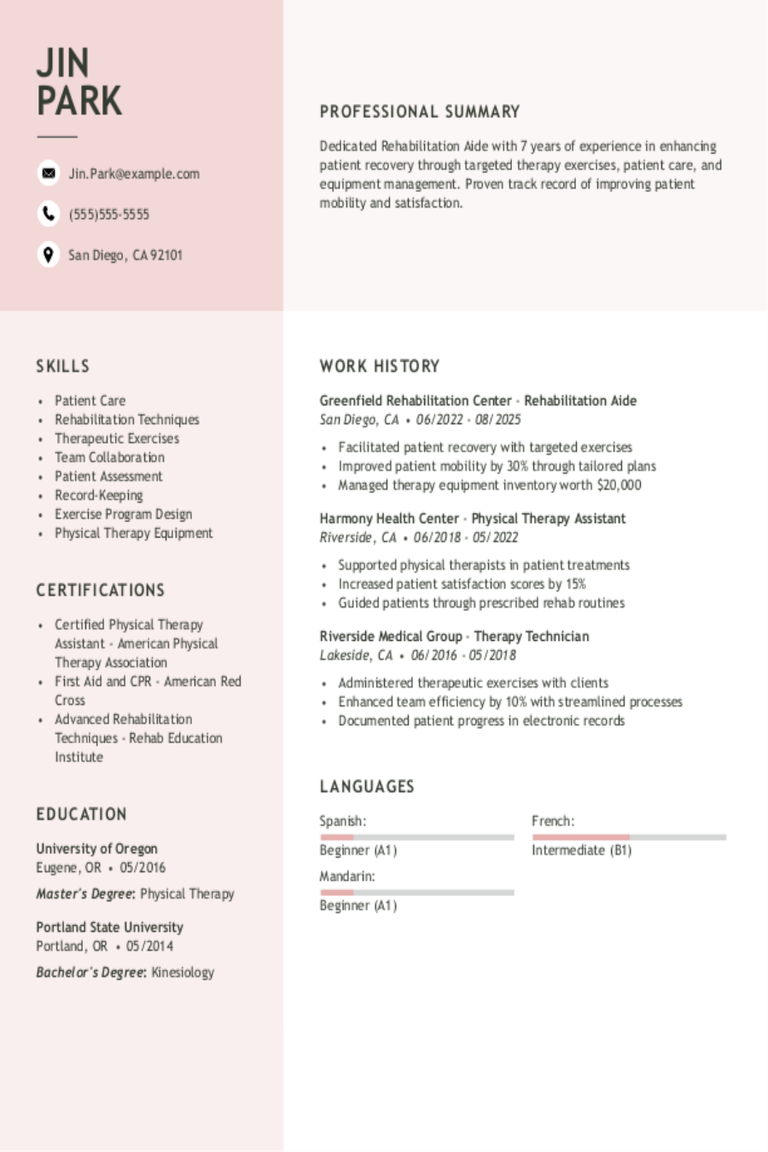
Rehabilitation Aide Resume Examples & Templates for 2025
Discover rehabilitation aide resume examples and tips that will help you highlight your skills in communication, teamwork, and attention to detail, making your resume stand out.Build my resumeImport existing resumeCustomize
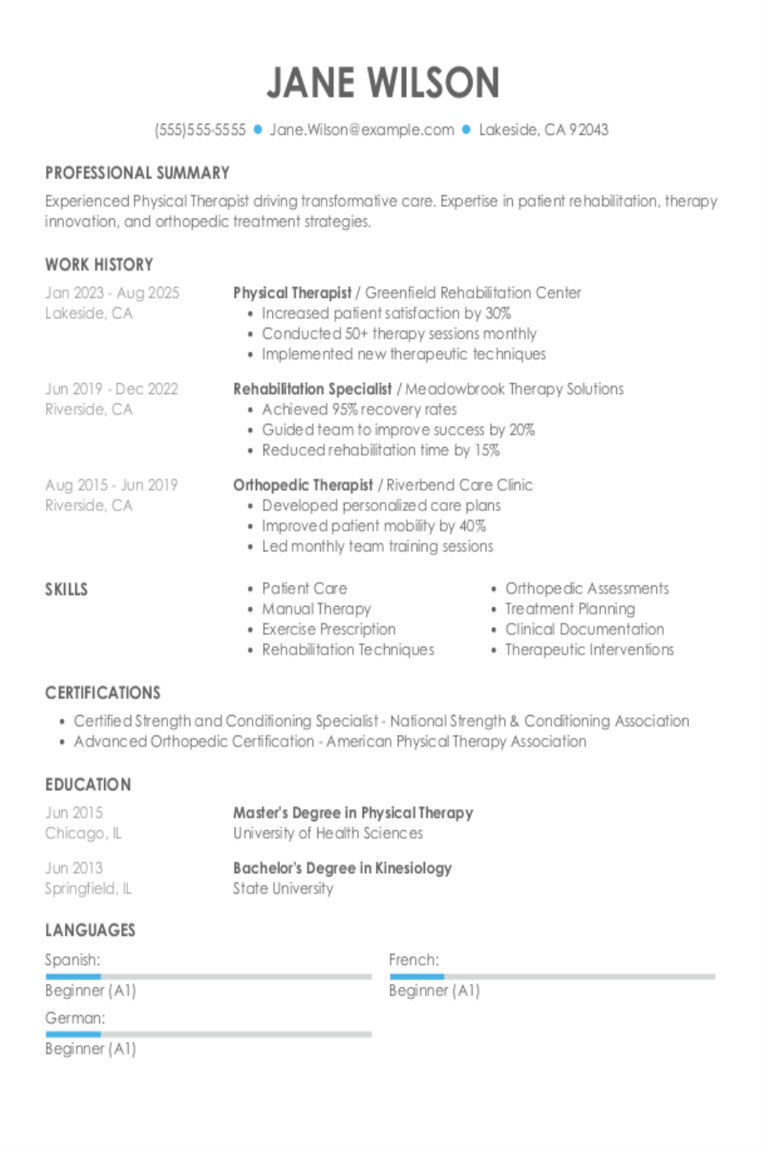
Physical Therapist Resume Examples & Templates for 2025
Discover physical therapist resume examples and learn how to showcase your ability to improve patient mobility and recovery.Build my resumeImport existing resumeCustomize this templateWhy this resume worksHighlights industry-specific skills: By incorporating
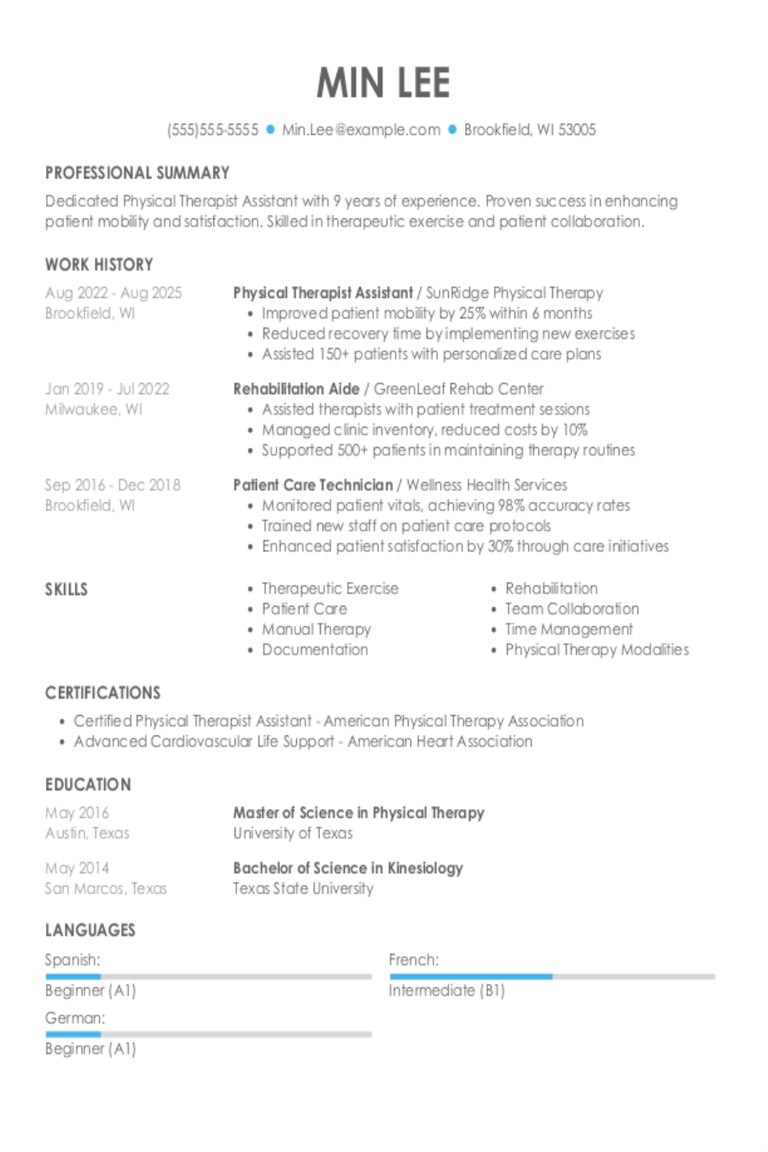
Physical Therapist Assistant Resume Examples & Templates for 2025
Explore physical therapist assistant resume examples and tips to help you showcase your teamwork skills and hands-on experience without sounding too technical.Build my resumeImport existing resumeCustomize this templateWhy this resume
